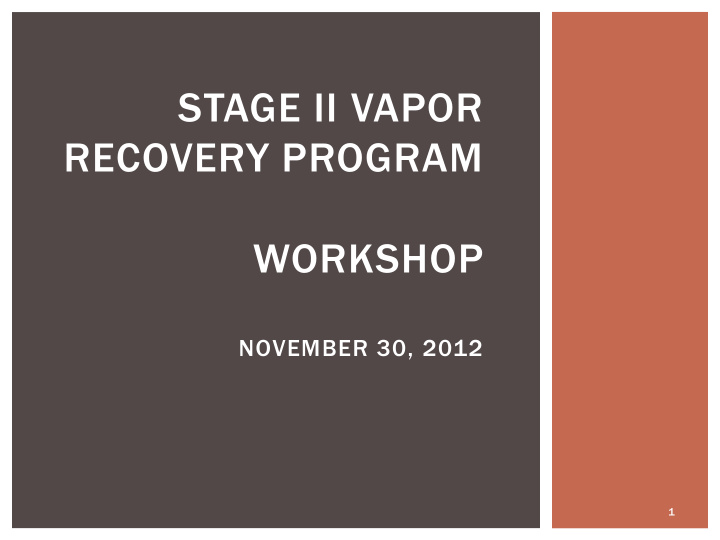



STAGE II VAPOR RECOVERY PROGRAM WORKSHOP NOVEMBER 30, 2012 1
COORDINATED EFFORT Arizona Department of Environmental Quality Arizona Department of Weights and Measures Maricopa Association of Governments Maricopa County Air Quality Department 2
WORKSHOP OVERVIEW Overview/Background EPA Actions Widespread Use Area A Stage II Widespread Use/Emission Reduction Analysis Stage II Options Feedback/Comments 3
BACKGROUND Stage II Vapor Recovery required under the Clean Air Act, Section 182(b)(3) and ARS Title 41, Chapter 15, Article 7 Statute passed in 1992 requiring Stage II Rules adopted by ADWM in August 1993 4
AREA A 5
STAGE I 6
STAGE II 7
ONBOARD REFUELING VAPOR RECOVERY (ORVR) 8
INCOMPATIBILITY BETWEEN ORVR AND STAGE II SYSTEMS 9
EPA WIDESPREAD USE DETERMINATION Final rule May 16, 2012 (77 FR 28772) Guidance document on removing Stage II from State Implementation Plan August 7,2012 States may choose (but are not required) to remove Stage II from their SIP 10
EPA REQUIREMENTS FOR REMOVAL OF STAGE II FROM THE SIP Submit SIP revision to EPA meets CAA 110(l) Demonstrate that the SIP revision will not: Interfere with attainment of the National Ambient Air Quality Standards Interfere with reasonable further progress Violate any other applicable requirements of the Clean Air Act EPA options for 110(l) demonstration Planned phase-out of Stage II does not increase emissions Planned phase-out increases emissions; however, the increased emissions are offset by adopting and implementing additional controls into the SIP Stage II program must be implemented until SIP revision is approved by EPA 11
EIGHT-HOUR OZONE MONITORING DATA Source: Maricopa Association of Governments 12
CALCULATING EMISSION REDUCTIONS FROM STAGE II Maricopa Association of Governments performed calculations to evaluate the emission reductions from the Stage II program Followed the August 7, 2012 EPA Guidance Document The EPA Guidance document equations account for: The overall control efficiency of the Stage II program The fraction of gasoline throughput through Stage II systems The control efficiency of ORVR systems Stage II systems that are incompatible with ORVR vehicles 13
CALCULATION INPUTS 1 Stage II vapor recovery system control efficiency : 67.4% 2 Fraction of gasoline throughput covered by Stage II: 0.95 3 In-use control efficiency for ORVR : 98% 4 % GDFs using Vacuum Assist Stage II : 82.8% 5 Uncontrolled displacement (non-ORVR) refueling emission 3.5 g/gal factor 6 CF = compatibility factor 7 ORVR vehicle population 8 VMT percentage 9 Gasoline dispensed percentage 10 Past and future projected gasoline consumption 14
EMISSION REDUCTIONS BASED ON EPA GUIDANCE EQUATIONS Note: these calculations are preliminary and are subject to change based on EPA review of methodology. 15
OPTION 1 Removal of Stage II equipment Revise SIP Develop decommissioning procedures as recommended by EPA Guidance Revise ADWM Stage II Rules Revise applicable statutes 16
OPTION 1 - ESTIMATED TIMELINE 17
OPTION 1 - DECOMMISSIONING EPA recommends currently available industry codes and standards be followed Petroleum Equipment Institute (PEI/RP300-09) Other states Other? 18
OPTION 1 - DECOMMISSIONING (2 TO 3 YEAR PROCESS) Drain liquid collection points Disconnect vapor vacuum motors and reprogram dispensers Drain fuel from vacuum pump Disconnect the below grade vapor piping from the dispenser at a point that is at or below the dispenser and seal with a permanent seal that is vapor tight If excavation is not required, disconnect the Stage II piping at the tank top and seal with a permanent vapor-tight seal Seal the dispenser cabinet vapor piping Replace hanging hardware Remove Stage II operating instructions from dispensers Conduct visual check, pressure decay, and tie-tank test to ensure Stage I equipment is operational 19
NEW STATIONS EPA rule and guidance does not provide an exemption for installation of Stage II equipment at new stations The final rule states: “According to requirements established by the CAA that are applicable here, states will need to develop and submit SIP revisions to the EPA in order to change or eliminate SIP- approved state rules that set forth the compliance dates for newly constructed GDFs.” 20
OPTION 2 Upgrade Stage II vapor recovery equipment to prevent emissions increases in 2018: Require equipment to be ORVR compatible Adopt California Phase II Enhanced Vapor Recovery Standards Other? 21
QUESTIONS TO EPA Several questions have been submitted to EPA: Calculation methodology Timing for removal of Stage II Contents for inclusion of the 110(l) submittal 22
FEEDBACK / COMMENTS Option 1 (removal of Stage II equipment) Option 2 (upgrade of Stage II equipment) New stations Costs/Impacts to businesses 23
LINKS EPA Final Rule – May 10, 2012 http://www.gpo.gov/fdsys/pkg/FR-2012-05-16/pdf/2012-11846.pdf EPA Fact Sheet http://www.epa.gov/airquality/ozonepollution/pdfs/20120509fs.pdf Guidance on Removing Stage 2 – August 7, 2012 http://www.epa.gov/groundlevelozone/pdfs/20120807guidance.pdf 24
CONTACT INFORMATION FOR COMMENTS Michelle Wilson Arizona Department of Weights and Measures 602-771-4933 mwilson@azdwm.gov Fax 623-939-8586 25
Recommend
More recommend